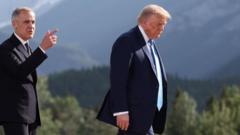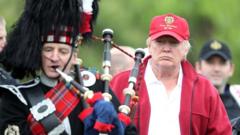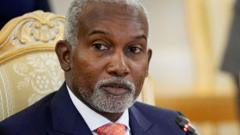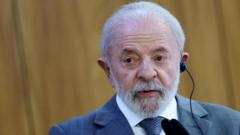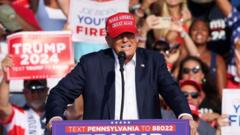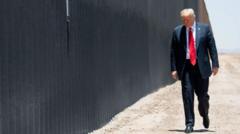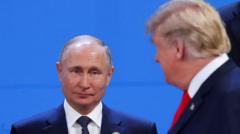The iconic presidential jet, often a symbol of power and authority, is facing challenges due to aging technology and rising maintenance costs, prompting potential upgrades from an unlikely international source.
A New Chapter for Air Force One: Will Qatar’s Lavish Offer Change Its Fate?
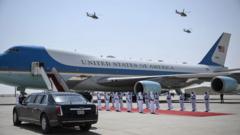
A New Chapter for Air Force One: Will Qatar’s Lavish Offer Change Its Fate?
The luxurious Qatari proposal for Air Force One raises questions about the future of presidential air travel.
In recent days, discussions surrounding Air Force One have intensified, particularly following Qatar's offer to supply a new, opulent "palace in the sky." This proposal, rumored to be valued at $400 million, signifies the largest foreign gift extended to a U.S. president. Yet, the complexities of accepting such a gift bring forth numerous technical and ethical considerations.
For most journalists accompanying the president, an intimate view of Air Force One's interior remains elusive, limited to a press compartment located at the rear of the aircraft. Gaining access to the iconic presidential suite, situated at the front, involves maneuvering past Secret Service agents overseeing the secured area. During a recent trip to the Middle East, discussions about Air Force One swirled around, with VIPs like Fox News host Sean Hannity receiving preferential treatment for interviews with President Trump, while the press pool faced restrictions in their designated area.
Air Force One's passenger quarters offer a semblance of luxury, boasting 14 first-class seats, a kitchenette with snacks — including unique Air Force One-branded M&Ms — and televisions often tuned to preferred networks. The existing planes, a pair of 747-200Bs in operation since 1990, are feeling the strains of age, which has become increasingly apparent to President Trump, who has long expressed desire for a newer model.
The Qatari offer comes at a time when the delayed delivery of two new presidential jets, previously scheduled for 2021, remains uncertain due to extensive cost overruns. Trump has openly voiced frustration about flying on a 42-year-old Boeing, suggesting that the promise of a new aircraft is tempting. His admiration for the Qatari jet also stems from its potential to address immediate needs, despite being fraught with logistical challenges related to retrofitting and security upgrades necessary for presidential use.
Experts note that transforming this foreign aircraft to meet American presidential standards could potentially incur costs upwards of $1 billion and take years, complicating the proposal further. Questions linger about the implications of accepting a lavish gift and whether Trump will wave certain security modifications. The current Air Force One jets have played pivotal roles in U.S. history, with six presidents having utilized them for significant events globally.
As the Air Force contemplates retiring its current fleet, the fate of Air Force One balances on the intersection of tradition, diplomacy, and the ever-evolving dynamics of presidential power. Ultimately, it remains a symbol of authority in an era where diplomacy and defense take flight.
For most journalists accompanying the president, an intimate view of Air Force One's interior remains elusive, limited to a press compartment located at the rear of the aircraft. Gaining access to the iconic presidential suite, situated at the front, involves maneuvering past Secret Service agents overseeing the secured area. During a recent trip to the Middle East, discussions about Air Force One swirled around, with VIPs like Fox News host Sean Hannity receiving preferential treatment for interviews with President Trump, while the press pool faced restrictions in their designated area.
Air Force One's passenger quarters offer a semblance of luxury, boasting 14 first-class seats, a kitchenette with snacks — including unique Air Force One-branded M&Ms — and televisions often tuned to preferred networks. The existing planes, a pair of 747-200Bs in operation since 1990, are feeling the strains of age, which has become increasingly apparent to President Trump, who has long expressed desire for a newer model.
The Qatari offer comes at a time when the delayed delivery of two new presidential jets, previously scheduled for 2021, remains uncertain due to extensive cost overruns. Trump has openly voiced frustration about flying on a 42-year-old Boeing, suggesting that the promise of a new aircraft is tempting. His admiration for the Qatari jet also stems from its potential to address immediate needs, despite being fraught with logistical challenges related to retrofitting and security upgrades necessary for presidential use.
Experts note that transforming this foreign aircraft to meet American presidential standards could potentially incur costs upwards of $1 billion and take years, complicating the proposal further. Questions linger about the implications of accepting a lavish gift and whether Trump will wave certain security modifications. The current Air Force One jets have played pivotal roles in U.S. history, with six presidents having utilized them for significant events globally.
As the Air Force contemplates retiring its current fleet, the fate of Air Force One balances on the intersection of tradition, diplomacy, and the ever-evolving dynamics of presidential power. Ultimately, it remains a symbol of authority in an era where diplomacy and defense take flight.

